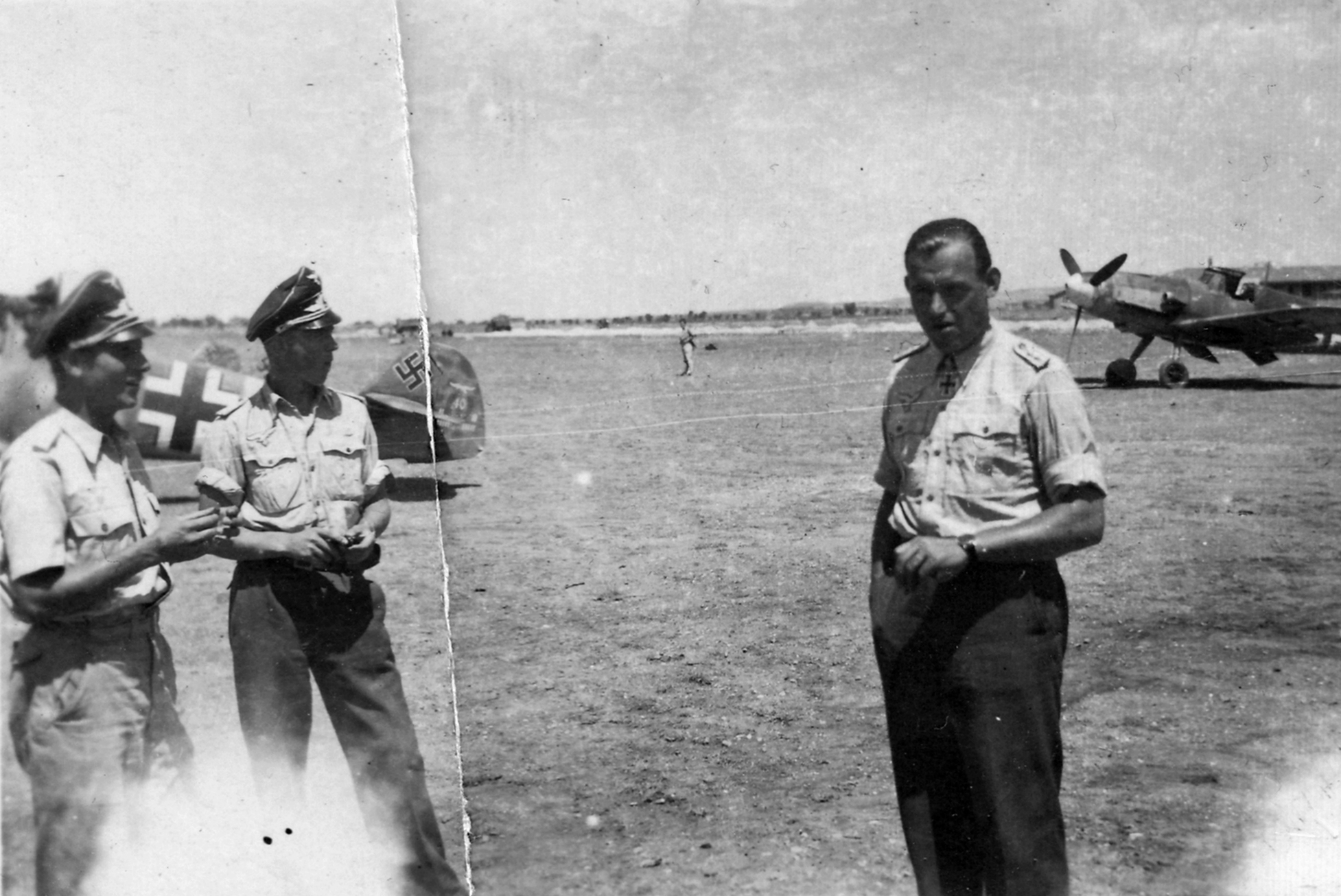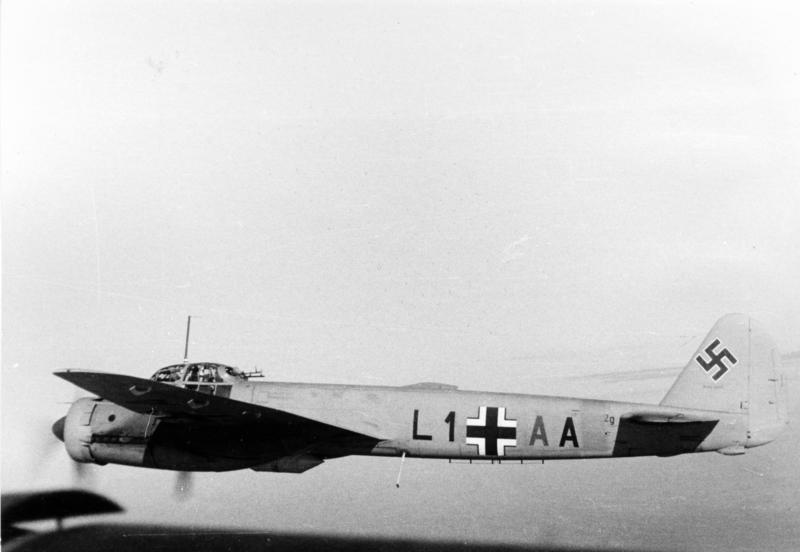|
Johannes Wiese
Johannes Wiese (7 March 1915 – 16 August 1991) was a German Luftwaffe pilot during World War II, a fighter ace credited with 133 enemy aircraft shot down in 480 combat missions. He claimed all of his victories over the Eastern Front, including over 50 Ilyushin Il-2 Shturmovik ground attack aircraft. Born in Breslau, Wiese volunteered for military service in the ''Reichswehr'' of Nazi Germany in 1934. Initially serving in the '' Heer'' (Army), he transferred to the Luftwaffe (Air Force) in 1936. Following flight training, he was posted to ''Jagdgeschwader'' 52 (JG 52—52nd Fighter Wing) in June 1941 just prior to Operation Barbarossa, the invasion of the Soviet Union. He claimed his first aerial victory on 23 September 1941. On 26 June 1942, Wiese was appointed ''Staffelkapitän'' (squadron leader) of the 2. '' Staffel'' (2nd squadron) of JG 52 and received the Knight's Cross of the Iron Cross on 5 January 1943 following his 53rd aerial victory. On 11 May 1 ... [...More Info...] [...Related Items...] OR: [Wikipedia] [Google] [Baidu] |
Fighter Ace
A flying ace, fighter ace or air ace is a military aviator credited with shooting down five or more enemy aircraft during aerial combat. The exact number of aerial victories required to officially qualify as an ace is varied, but is usually considered to be five or more. The concept of the "ace" emerged in 1915 during World War I, at the same time as aerial dogfighting. It was a propaganda term intended to provide the home front with a cult of the hero in what was otherwise a war of attrition. The individual actions of aces were widely reported and the image was disseminated of the ace as a chivalrous knight reminiscent of a bygone era. For a brief early period when air-to-air combat was just being invented, the exceptionally skilled pilot could shape the battle in the skies. For most of the war, however, the image of the ace had little to do with the reality of air warfare, in which fighters fought in formation and air superiority depended heavily on the relative availability ... [...More Info...] [...Related Items...] OR: [Wikipedia] [Google] [Baidu] |
Geschwaderkommodore
{{unreferenced, date=May 2019 ''Geschwaderkommodore'' (short also ''Kommodore'') is a ''Luftwaffe'' position or appointment (not rank), originating during World War II. A ''Geschwaderkommodore'' is usually an OF5-rank of ''Oberst'' (colonel) or Kapitän zur See (naval captain). A ''Geschwaderkommodore'' will command a ''Geschwader'' (Wing), which in turn contains ''Gruppen'' (Groups) each commanded by a '' Gruppenkommandeur'' (Group Commander). See also * Organization of the Luftwaffe (1933–1945) Between 1933 and 1945, the organization of the Luftwaffe underwent several changes. Originally, the German military high command, for their air warfare forces, decided to use an organizational structure similar to the army and navy, treating the ... Luftwaffe Air force appointments German Air Force ... [...More Info...] [...Related Items...] OR: [Wikipedia] [Google] [Baidu] |
Jagdgeschwader 77
''Jagdgeschwader'' 77 (JG 77) ''Herz As'' ("Ace of Hearts") was a Luftwaffe fighter wing during World War II. It served in all the German theaters of war, from Western Europe to the Eastern Front, and from the high north in Norway to the Mediterranean. All three ''gruppen'' (groups) within the unit operated variants of the Messerschmitt Bf 109. II. Gruppe was the only German unit entirely equipped, albeit only during November–December 1943, with the Macchi C.205, a highly regarded Italian fighter. Formation Initially, JG 77 was created with two ''Gruppen'' (groups) and without a ''Geschwaderstab'' (headquarters unit). I. ''Gruppe'' of JG 77 was created from IV. ''Gruppe'' of ''Jagdgeschwader'' 132 (JG 132—132nd Fighter Wing), which had become I. ''Gruppe'' of ''Jagdgeschwader'' 331 (JG 331—331st Fighter Wing) on 3 November 1938 before it was renamed to I. ''Gruppe'' of JG 77 on 1 May 1939. II. ''Gruppe'' of JG 77 was derived from one of the ... [...More Info...] [...Related Items...] OR: [Wikipedia] [Google] [Baidu] |
Stab (Luftwaffe Designation)
The German language term ''Stab'' (literal translation: " staff") was used during World War II to designate a headquarters unit of the German ''Luftwaffe'' (air force). There were ''Stab'' units at the level of a '' Gruppe'' or ''Geschwader'' – units that were equivalent to wings and groups in the air forces of the English-speaking world. ''Stab'' units directly controlled aircraft as well as controlling those belonging to subordinate units. These command units used the mandated blue or green "staff aircraft" colour for the third character (the individual aircraft's letter) of their alphanumeric ''Geschwaderkennung'' wing code, to distinguish their aircraft from the rest of air units in the same unit. These units were divided in the following form, for the fourth and last character normally used to distinguish individual '' Staffeln'' (squadrons) from the letter "H" onwards in Luftwaffe wing codes: *''Geschwader Stab'' = A (third letter blue) *''Stab I Gruppe'' ("Staff U ... [...More Info...] [...Related Items...] OR: [Wikipedia] [Google] [Baidu] |
Gruppenkommandeur
''Gruppenkommandeur'' is a Luftwaffe position (not rank), that is the equivalent of a commander of a group or wing in other air forces. A ''Gruppenkommandeur'' usually has the rank of Major or ''Oberstleutnant'' (Lieutenant Colonel), and commands a '' Gruppe'', which is a sub-unit of a ''Geschwader''. A ''Gruppe'' usually consists of three or four '' Staffeln'' (each of which is commanded by a ''Staffelkapitän''). See also *Organization of the Luftwaffe (1933–1945) Between 1933 and 1945, the organization of the Luftwaffe underwent several changes. Originally, the German military high command, for their air warfare forces, decided to use an organizational structure similar to the army and navy, treating the ... Military ranks of Germany Luftwaffe Air force appointments {{aviation-stub ... [...More Info...] [...Related Items...] OR: [Wikipedia] [Google] [Baidu] |
Knight's Cross Of The Iron Cross
The Knight's Cross of the Iron Cross (german: Ritterkreuz des Eisernen Kreuzes), or simply the Knight's Cross (), and its variants, were the highest awards in the military and paramilitary forces of Nazi Germany during World War II. The Knight's Cross was awarded for a wide range of reasons and across all ranks, from a senior commander for skilled leadership of his troops in battle to a low-ranking soldier for a single act of military valour. Presentations were made to members of the three military branches of the : the (army), the (navy) and the (air force), as well as the , the Reich Labour Service and the (German People storm militia), along with personnel from other Axis powers. The award was instituted on 1 September 1939, at the onset of the German invasion of Poland. The award was created to replace the many older merit and bravery neck awards of the German Empire. A higher grade, the Oak Leaves to the Knight's Cross, was instituted in 1940. In 1941, two higher grades ... [...More Info...] [...Related Items...] OR: [Wikipedia] [Google] [Baidu] |
Organization Of The Luftwaffe (1933–1945)
Between 1933 and 1945, the organization of the Luftwaffe underwent several changes. Originally, the German military high command, for their air warfare forces, decided to use an organizational structure similar to the army and navy, treating the aviation branch as a strategic weapon of war. Later on, during the period of rapid rearmament, the Luftwaffe was organized more in a geographical fashion. Under the terms of the Treaty of Versailles (1919), Germany was prohibited from having an air force, with the former German Empire's ''Luftstreitkräfte'' disbandment in 1920. German pilots were secretly trained for military aviation, first in the Soviet Union during the late 1920s, and then in Germany in the early 1930s. In Germany, the training was done under the guise of the German Air Sports Association (german: Deutscher Luftsportverband (DLV)) at the Central Commercial Pilots School (german: Zentrale der Verkehrs Fliegerschule (ZVF)). Following its 15 May 1933 formation in secret, ... [...More Info...] [...Related Items...] OR: [Wikipedia] [Google] [Baidu] |
Staffelkapitän
''Staffelkapitän'' is a position (not a rank) in flying units ( ''Staffel'') of the German Luftwaffe that is the equivalent of RAF/USAF Squadron Commander. Usually today a ''Staffelkapitän'' is of ''Oberstleutnant'' or ''Major'' rank. In the ''Luftwaffe'' of the Wehrmacht the ''Staffelkapitän'' usually held the rank of an ''Oberleutnant'' or ''Hauptmann''. For the first weeks of his assignment he was known as a ''Staffelführer'' (Squadron Leader), until he was confirmed in this position. If a Non-commissioned officer was tasked with this role, he was also referred to as a ''Staffelführer''. This title is not to be confused with ''Staffelführer'', a rank in the SS. See also *Organization of the Luftwaffe (1933–1945) Between 1933 and 1945, the organization of the Luftwaffe underwent several changes. Originally, the German military high command, for their air warfare forces, decided to use an organizational structure similar to the army and navy, treating the ... Refere ... [...More Info...] [...Related Items...] OR: [Wikipedia] [Google] [Baidu] |
Jagdgeschwader 52
''Jagdgeschwader'' 52 (JG 52) was a German World War II fighter ''Geschwader'' (wing) that exclusively used the Messerschmitt Bf 109 throughout the war. The unit originally formed near Munich in November 1938, then moved to a base near Stuttgart. JG 52 became the most successful fighter-''Geschwader'' of the war, with a claimed total of more than 10,000 victories over enemy aircraft during World War II. It was the unit of the top three scoring flying aces of all time, Erich Hartmann, Gerhard Barkhorn and Günther Rall. Formation In 1935, the Ministry of Aviation designed an air force (''Luftwaffe'') of 2,370 active planes by April 1938, which would require the production of about 18,000 planes to cover attrition. When 1938 came, the Luftwaffe split its fighter groups into light "Jagdgeschwader" flying the Messerschmitt Bf 109, for home defense, and heavy fighter wings called ''Zerstörergeschwader'' flying the Messerschmitt Bf 110, for offensive operations, based on doctrine ... [...More Info...] [...Related Items...] OR: [Wikipedia] [Google] [Baidu] |
Wehrmacht
The ''Wehrmacht'' (, ) were the unified armed forces of Nazi Germany from 1935 to 1945. It consisted of the ''Heer'' (army), the ''Kriegsmarine'' (navy) and the ''Luftwaffe'' (air force). The designation "''Wehrmacht''" replaced the previously used term and was the manifestation of the Nazi regime's efforts to rearm Germany to a greater extent than the Treaty of Versailles permitted. After the Nazi rise to power in 1933, one of Adolf Hitler's most overt and audacious moves was to establish the ''Wehrmacht'', a modern offensively-capable armed force, fulfilling the Nazi régime's long-term goals of regaining lost territory as well as gaining new territory and dominating its neighbours. This required the reinstatement of conscription and massive investment and defense spending on the arms industry. The ''Wehrmacht'' formed the heart of Germany's politico-military power. In the early part of the Second World War, the ''Wehrmacht'' employed combined arms tactics (close-cover ... [...More Info...] [...Related Items...] OR: [Wikipedia] [Google] [Baidu] |
Nazi Germany
Nazi Germany (lit. "National Socialist State"), ' (lit. "Nazi State") for short; also ' (lit. "National Socialist Germany") (officially known as the German Reich from 1933 until 1943, and the Greater German Reich from 1943 to 1945) was the German state between 1933 and 1945, when Adolf Hitler and the Nazi Party controlled the country, transforming it into a dictatorship. Under Hitler's rule, Germany quickly became a totalitarian state where nearly all aspects of life were controlled by the government. The Third Reich, meaning "Third Realm" or "Third Empire", alluded to the Nazi claim that Nazi Germany was the successor to the earlier Holy Roman Empire (800–1806) and German Empire (1871–1918). The Third Reich, which Hitler and the Nazis referred to as the Thousand-Year Reich, ended in May 1945 after just 12 years when the Allies defeated Germany, ending World War II in Europe. On 30 January 1933, Hitler was appointed chancellor of Germany, the head of gove ... [...More Info...] [...Related Items...] OR: [Wikipedia] [Google] [Baidu] |






